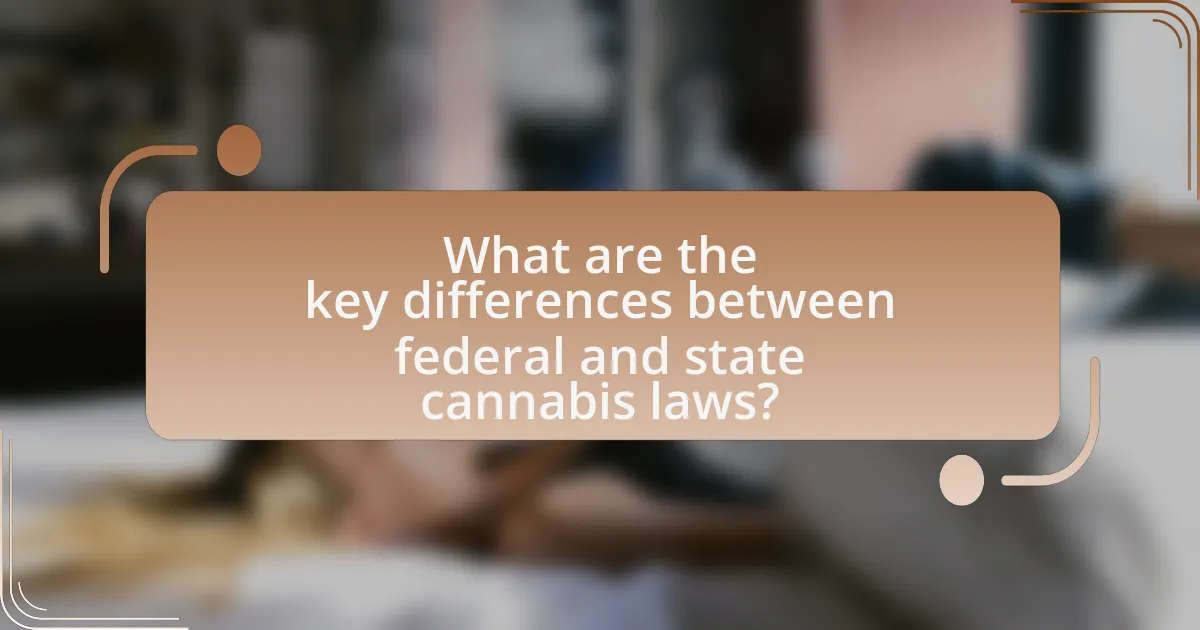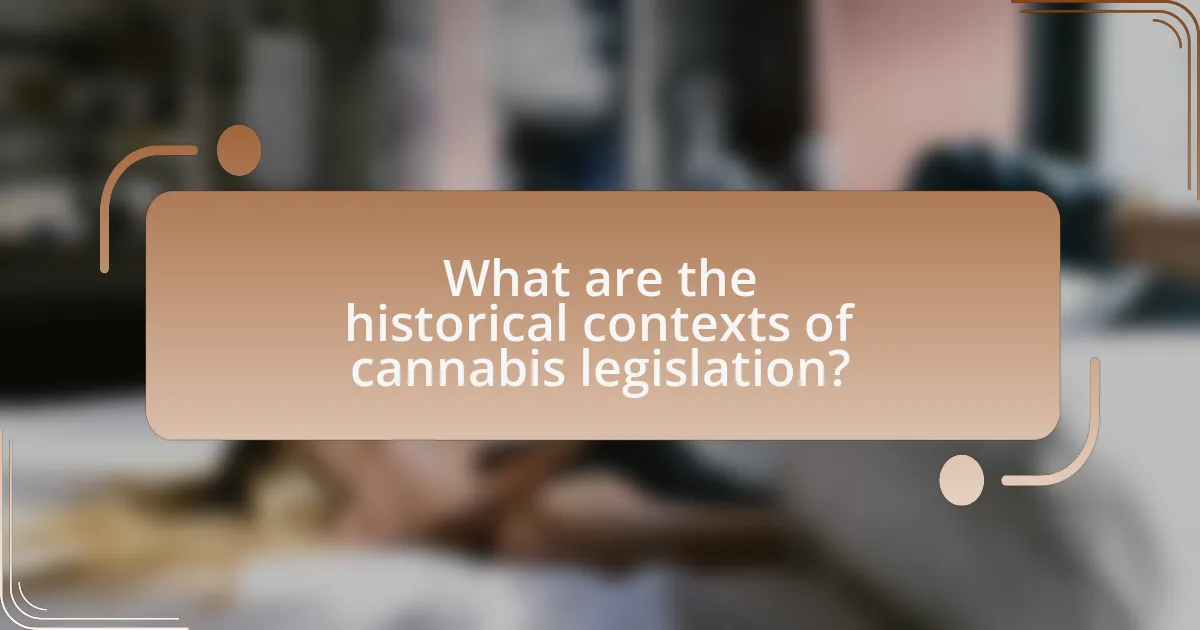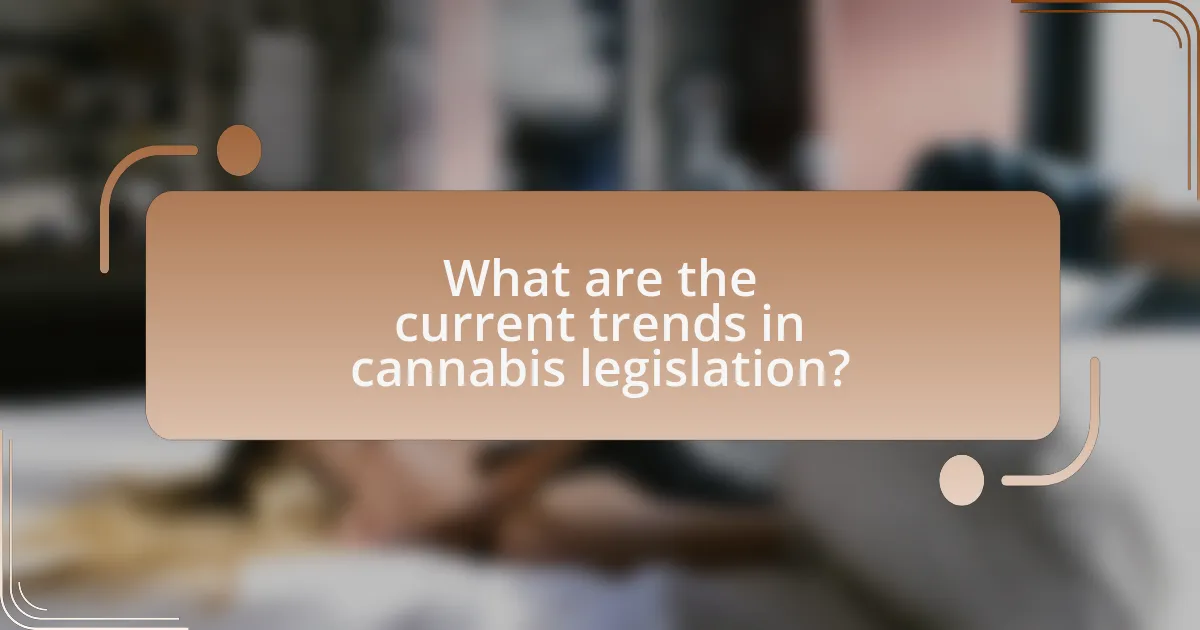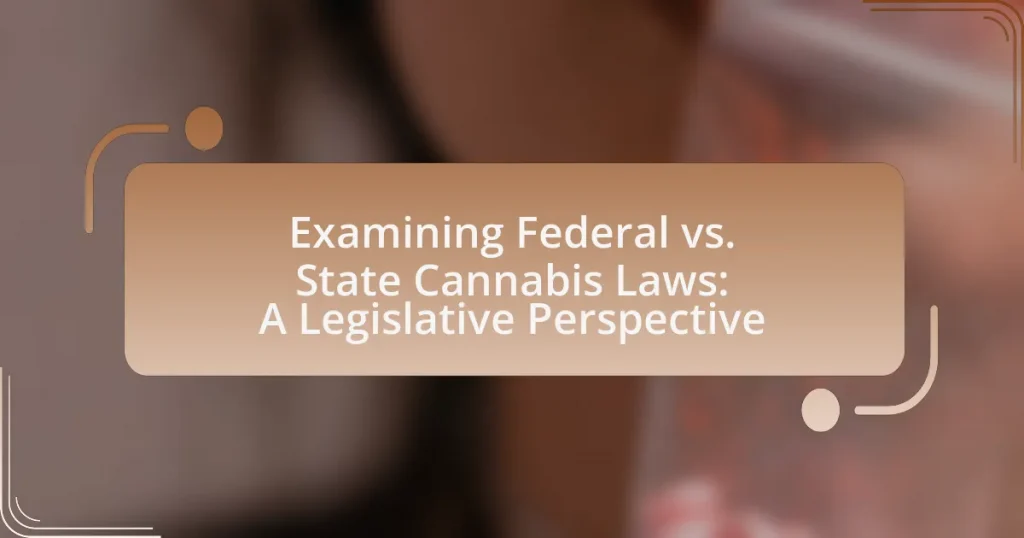The article examines the key differences between federal and state cannabis laws, highlighting the federal classification of marijuana as a Schedule I controlled substance under the Controlled Substances Act, which renders its possession and use illegal nationwide. In contrast, many states have enacted laws legalizing cannabis for medical or recreational use, resulting in a complex legal landscape characterized by varying regulations, enforcement challenges, and implications for businesses and individuals. The article also discusses the historical context of cannabis legislation, current trends in legalization, and the impact of federal policies on state laws, providing a comprehensive overview of the ongoing conflict and its significance in the evolving cannabis industry.

What are the key differences between federal and state cannabis laws?
Federal cannabis laws classify marijuana as a Schedule I controlled substance under the Controlled Substances Act, making its possession, distribution, and use illegal nationwide. In contrast, state cannabis laws vary significantly, with many states legalizing marijuana for medical or recreational use, creating a legal framework that allows for regulated sales and use within their jurisdictions. For example, as of October 2023, over 20 states have legalized recreational cannabis, while others permit medical use, demonstrating a clear divergence from federal prohibition. This discrepancy leads to conflicts in enforcement, banking, and taxation, as federal law does not recognize state-level legalization, complicating the legal landscape for cannabis businesses operating in states where it is legal.
How do federal cannabis laws define legality?
Federal cannabis laws define legality primarily through the Controlled Substances Act (CSA), which classifies cannabis as a Schedule I substance, indicating it is illegal under federal law. This classification asserts that cannabis has a high potential for abuse, no accepted medical use, and a lack of accepted safety for use under medical supervision. Consequently, federal law prohibits the cultivation, distribution, and possession of cannabis, regardless of state laws that may permit its use for medical or recreational purposes. The federal stance has been reinforced by various court rulings and enforcement actions, which uphold the CSA’s classification and the federal government’s authority to regulate controlled substances.
What are the main federal statutes governing cannabis?
The main federal statutes governing cannabis are the Controlled Substances Act (CSA) and the Agricultural Improvement Act of 2018 (commonly known as the Farm Bill). The CSA classifies cannabis as a Schedule I substance, which indicates it has a high potential for abuse and no accepted medical use, thereby prohibiting its manufacture, distribution, and possession. In contrast, the Agricultural Improvement Act of 2018 legalized hemp-derived products containing less than 0.3% THC, effectively distinguishing hemp from marijuana under federal law. This distinction has significant implications for the regulation and commercialization of cannabis-related products.
How does the federal government classify cannabis?
The federal government classifies cannabis as a Schedule I controlled substance under the Controlled Substances Act. This classification indicates that cannabis is considered to have a high potential for abuse, no accepted medical use in treatment in the United States, and a lack of accepted safety for use under medical supervision. The Schedule I designation has significant legal implications, affecting research, medical use, and law enforcement related to cannabis.
What variations exist in state cannabis laws?
Variations in state cannabis laws include differences in legalization status, possession limits, cultivation regulations, and medical use provisions. For instance, some states have fully legalized recreational cannabis, such as California and Colorado, while others, like Texas, maintain strict prohibitions. Additionally, states like Oregon allow for personal cultivation, whereas states like New Jersey impose restrictions on the number of plants an individual can grow. Medical cannabis laws also vary significantly; states such as Florida have extensive medical programs, while others may only permit CBD oil with low THC content. These differences reflect the diverse approaches states take in regulating cannabis, influenced by local political, social, and economic factors.
How do states differ in their legalization approaches?
States differ in their legalization approaches primarily through variations in the legal status of cannabis, regulatory frameworks, and implementation strategies. For instance, some states like California and Colorado have fully legalized cannabis for both medical and recreational use, establishing comprehensive regulatory systems that include licensing, taxation, and safety standards. In contrast, states such as Texas maintain strict prohibitions, allowing only limited medical use under specific conditions. Additionally, states like New York have adopted progressive measures that prioritize social equity in their legalization processes, while others may focus more on revenue generation. These differences reflect diverse political, cultural, and economic contexts, influencing how each state navigates the complexities of cannabis legalization.
What are the implications of state-specific regulations?
State-specific regulations significantly impact the cannabis industry by creating a patchwork of legal frameworks that businesses must navigate. These regulations can lead to inconsistencies in compliance requirements, taxation, and operational procedures across different states, complicating interstate commerce and limiting market expansion. For instance, while some states have legalized recreational cannabis, others maintain strict prohibitions, resulting in varied consumer access and business opportunities. According to the National Conference of State Legislatures, as of 2023, 21 states have legalized recreational cannabis, while 14 states still prohibit it entirely, illustrating the diverse regulatory landscape. This disparity can hinder investment and innovation in the cannabis sector, as companies may face legal risks when attempting to operate in multiple jurisdictions.
Why is the conflict between federal and state laws significant?
The conflict between federal and state laws is significant because it creates legal uncertainty and challenges for individuals and businesses, particularly in areas like cannabis regulation. This conflict arises when state laws permit activities, such as cannabis use and distribution, that are prohibited under federal law, leading to confusion regarding legal rights and responsibilities. For example, despite states like California and Colorado legalizing cannabis, it remains classified as a Schedule I substance under the Controlled Substances Act, which complicates banking, taxation, and employment for cannabis-related businesses. This legal dichotomy can result in federal enforcement actions against state-legal operations, undermining state sovereignty and creating a patchwork of laws that complicates compliance for citizens and businesses alike.
What challenges do individuals face due to this conflict?
Individuals face legal uncertainty and potential criminal charges due to the conflict between federal and state cannabis laws. This discrepancy creates a situation where individuals in states that have legalized cannabis may still be subject to federal prosecution, leading to confusion about their legal rights. For instance, despite states like California and Colorado allowing recreational use, federal law classifies cannabis as a Schedule I substance, which can result in arrests and penalties for users and providers. Additionally, individuals may encounter difficulties accessing banking services, as many financial institutions are hesitant to work with cannabis-related businesses due to federal regulations, further complicating their ability to operate legally and securely.
How does this conflict affect businesses operating in the cannabis industry?
The conflict between federal and state cannabis laws significantly affects businesses operating in the cannabis industry by creating legal uncertainties and operational challenges. Businesses face difficulties in accessing banking services, as federal law classifies cannabis as a Schedule I substance, leading to a lack of financial support from federally insured banks. Additionally, companies may encounter challenges in tax compliance, as Section 280E of the Internal Revenue Code prohibits cannabis businesses from deducting ordinary business expenses, resulting in higher effective tax rates. This legal dichotomy can deter investment and limit growth opportunities, as investors may be wary of potential federal enforcement actions against state-legal operations.

What are the historical contexts of cannabis legislation?
The historical contexts of cannabis legislation include a series of legal and social developments that have shaped its regulation over time. Initially, cannabis was widely used in the 19th century for medicinal purposes and was included in various pharmacopoeias. However, the early 20th century saw a shift, with the 1937 Marihuana Tax Act effectively criminalizing cannabis in the United States, driven by social stigma and political agendas. This was further reinforced by the Controlled Substances Act of 1970, which classified cannabis as a Schedule I drug, indicating a high potential for abuse and no accepted medical use. In recent decades, a growing movement for legalization emerged, leading to state-level reforms beginning with California’s Proposition 215 in 1996, which allowed medical use. By 2023, numerous states had legalized cannabis for recreational use, reflecting changing public attitudes and ongoing debates about federal versus state authority in cannabis regulation.
How has federal cannabis policy evolved over time?
Federal cannabis policy has evolved significantly from strict prohibition to a more lenient approach. Initially, the Marihuana Tax Act of 1937 effectively criminalized cannabis, leading to its classification as a Schedule I substance under the Controlled Substances Act of 1970, which deemed it to have no accepted medical use and a high potential for abuse. Over time, public opinion shifted, and in the 1990s, states began legalizing medical cannabis, prompting the federal government to adopt a more hands-off approach, particularly during the Obama administration, which issued the Cole Memo in 2013, allowing states to implement their own cannabis laws without federal interference. As of 2023, the federal landscape continues to change, with ongoing discussions about potential legalization and reform, reflecting a growing recognition of cannabis’s medical benefits and the failures of prohibition.
What major legislative acts have influenced federal cannabis laws?
The major legislative acts that have influenced federal cannabis laws include the Controlled Substances Act of 1970, the Marijuana Tax Act of 1937, and the Agricultural Improvement Act of 2018. The Controlled Substances Act classified cannabis as a Schedule I substance, which significantly restricted its use and research. The Marijuana Tax Act imposed strict regulations and taxes on cannabis, effectively criminalizing its use. The Agricultural Improvement Act, also known as the Farm Bill, legalized hemp-derived CBD products containing less than 0.3% THC, marking a shift in federal cannabis policy. These acts collectively shaped the legal landscape surrounding cannabis at the federal level.
How have public perceptions of cannabis changed historically?
Public perceptions of cannabis have shifted significantly over time, moving from widespread stigma and criminalization to increasing acceptance and legalization. In the early 20th century, cannabis was largely viewed as a dangerous substance, leading to its prohibition in the 1930s, exemplified by the Marihuana Tax Act of 1937, which criminalized its use and distribution. However, by the late 20th century, particularly in the 1990s, attitudes began to change as advocacy for medical cannabis gained traction, culminating in California’s legalization of medical marijuana in 1996.
Recent surveys indicate that as of 2021, approximately 68% of Americans support legalizing cannabis, reflecting a dramatic shift in public opinion over the past few decades. This change is supported by various studies, including a 2020 Gallup poll, which showed that support for legalization has steadily increased from just 12% in 1970 to the current majority. The evolving perception is also influenced by the recognition of potential medical benefits, economic opportunities, and social justice considerations surrounding cannabis use and its historical criminalization.
What role have states played in shaping cannabis laws?
States have played a crucial role in shaping cannabis laws by enacting their own legislation that often diverges from federal regulations. As of October 2023, 23 states and Washington D.C. have legalized recreational cannabis, while 38 states have approved medical cannabis programs. This state-level action has created a patchwork of laws across the country, influencing public perception and policy discussions regarding cannabis. For instance, states like Colorado and California have set precedents for regulatory frameworks that other states have adopted or adapted, demonstrating the impact of state legislation on national cannabis policy.
Which states were pioneers in cannabis legalization?
California and Colorado were pioneers in cannabis legalization. California was the first state to legalize medical cannabis in 1996 with Proposition 215, setting a precedent for other states. Colorado followed by legalizing recreational cannabis in 2012 through Amendment 64, becoming the first state to do so. These actions significantly influenced the national conversation on cannabis policy and inspired subsequent legalization efforts across the United States.
How have state initiatives influenced federal discussions?
State initiatives have significantly influenced federal discussions on cannabis legalization by demonstrating public support and practical frameworks for regulation. For instance, as of October 2023, over 30 states have legalized cannabis for medical or recreational use, prompting federal lawmakers to reconsider existing policies. The success of state-level programs, such as Colorado’s regulated market, has provided a model for potential federal legislation, showcasing economic benefits and public health outcomes. This shift in state policy has led to increased dialogue in Congress, with proposals like the Cannabis Administration and Opportunity Act gaining traction, reflecting the changing attitudes towards cannabis at the federal level.
What lessons can be learned from historical cannabis legislation?
Historical cannabis legislation teaches that regulatory approaches can significantly impact public health, criminal justice, and economic outcomes. For instance, the prohibition era in the early 20th century led to increased criminalization and social stigma surrounding cannabis use, which disproportionately affected marginalized communities. The shift towards legalization in various states has demonstrated that regulated markets can reduce illegal trade, generate tax revenue, and improve access for medical patients. Data from states like Colorado, which legalized recreational cannabis in 2012, shows a decrease in cannabis-related arrests and an increase in tax revenue, highlighting the potential benefits of a regulated framework. These lessons underscore the importance of considering social equity and public health in future cannabis legislation.
How can past legislative outcomes inform future policies?
Past legislative outcomes can inform future policies by providing data on the effectiveness and public reception of previous laws. For instance, the legalization of cannabis in various states has led to significant tax revenue increases and reductions in law enforcement costs, as evidenced by Colorado’s $1.5 billion in tax revenue since legalization in 2014. Analyzing these outcomes allows policymakers to identify successful strategies and potential pitfalls, guiding the development of more effective legislation. Additionally, public opinion trends following these legislative changes can indicate societal readiness for similar policies, further shaping future legislative approaches.
What historical precedents exist for resolving federal-state conflicts?
Historical precedents for resolving federal-state conflicts include the Supremacy Clause of the U.S. Constitution, which establishes that federal law takes precedence over state law. This principle was affirmed in landmark cases such as McCulloch v. Maryland (1819), where the Supreme Court ruled that states cannot tax federal institutions, and Gibbons v. Ogden (1824), which reinforced federal authority over interstate commerce. Additionally, the Civil Rights Movement led to federal intervention in state laws, exemplified by the Civil Rights Act of 1964, which prohibited discrimination despite state laws to the contrary. These precedents illustrate the mechanisms through which federal authority can resolve conflicts with state laws, particularly in areas of national importance.

What are the current trends in cannabis legislation?
Current trends in cannabis legislation indicate a growing movement towards legalization and decriminalization at both state and federal levels in the United States. As of 2023, 21 states and Washington D.C. have legalized recreational cannabis, while 37 states permit medical use, reflecting a significant shift in public opinion and policy. Additionally, there is increasing advocacy for federal reform, including proposals to deschedule cannabis from the Controlled Substances Act, which would align federal law with state laws and facilitate broader access and regulation. This trend is supported by data showing that a majority of Americans now favor legalization, with a Gallup poll indicating that 68% support legalizing cannabis as of 2021.
How are states currently approaching cannabis legalization?
States are currently approaching cannabis legalization through a mix of full legalization, decriminalization, and medical use laws. As of October 2023, 23 states and Washington D.C. have legalized recreational cannabis, while 38 states permit medical cannabis use. This trend reflects a growing acceptance of cannabis, driven by public support and potential tax revenue. For instance, states like California and Colorado have generated significant tax income from cannabis sales, with Colorado reporting over $2 billion in tax revenue since legalization in 2014. Additionally, states are increasingly implementing regulatory frameworks to manage the cannabis industry, ensuring safety and compliance.
What factors are driving recent state-level legalization efforts?
Recent state-level legalization efforts are primarily driven by public opinion, economic benefits, and social justice considerations. Public support for cannabis legalization has increased significantly, with a Gallup poll in 2021 indicating that 68% of Americans favor legalizing marijuana. This shift in public sentiment encourages lawmakers to pursue legalization. Additionally, states recognize the potential economic benefits, such as increased tax revenue and job creation; for instance, Colorado generated over $387 million in tax revenue from cannabis sales in 2020. Lastly, social justice issues, including the desire to rectify past injustices related to cannabis prohibition, motivate states to implement legalization measures, as seen in states like New York, which included expungement of past convictions in its legalization law.
How do public opinion and advocacy groups influence state laws?
Public opinion and advocacy groups influence state laws by mobilizing citizens, shaping legislative agendas, and providing resources for policy change. Advocacy groups often conduct campaigns that raise awareness about specific issues, such as cannabis legalization, which can shift public sentiment and pressure lawmakers to act. For instance, the National Organization for the Reform of Marijuana Laws (NORML) has played a significant role in advocating for cannabis reform, leading to the legalization of cannabis in multiple states. Additionally, public opinion polls consistently show that as support for cannabis legalization increases among the general population, state legislatures are more likely to introduce and pass related legislation. This correlation demonstrates the direct impact of public sentiment and organized advocacy on the legislative process.
What is the federal government’s stance on cannabis reform today?
The federal government’s stance on cannabis reform today is one of cautious consideration, with ongoing discussions about potential legalization and decriminalization. As of October 2023, cannabis remains classified as a Schedule I substance under the Controlled Substances Act, indicating that it is considered to have a high potential for abuse and no accepted medical use. However, recent legislative efforts, such as the introduction of the Cannabis Administration and Opportunity Act, aim to facilitate the legalization of cannabis at the federal level, reflecting a shift in public opinion and state-level legalization trends. This evolving stance is supported by various polls indicating that a majority of Americans favor legalization, which influences lawmakers to reconsider federal policies regarding cannabis.
What recent federal proposals have been introduced regarding cannabis?
Recent federal proposals regarding cannabis include the Cannabis Administration and Opportunity Act, which aims to decriminalize cannabis at the federal level and establish a regulatory framework for its use and distribution. This proposal, introduced in 2021, seeks to remove cannabis from the Controlled Substances Act, allowing states to regulate cannabis without federal interference. Additionally, the SAFE Banking Act has been proposed to enable financial institutions to provide services to cannabis businesses, addressing the banking challenges faced by the industry. These proposals reflect a growing trend in Congress to reform cannabis laws and align federal regulations with the increasing number of states legalizing cannabis for medical and recreational use.
How do federal enforcement policies impact state laws?
Federal enforcement policies significantly influence state laws by establishing a legal framework that can either support or undermine state legislation. For instance, the federal classification of cannabis as a Schedule I substance under the Controlled Substances Act creates a conflict with states that have legalized cannabis for medical or recreational use. This federal stance can lead to federal law enforcement actions against state-licensed businesses, creating uncertainty and risk for those operating under state law. Additionally, federal policies, such as the Cole Memorandum (which was rescinded in 2018), previously provided guidance that allowed states to regulate cannabis without federal interference, demonstrating how federal enforcement can shape state approaches to cannabis legislation.
What practical steps can stakeholders take in navigating cannabis laws?
Stakeholders can navigate cannabis laws by conducting thorough research on both federal and state regulations. This involves reviewing the specific cannabis laws applicable in their state, as regulations can vary significantly; for instance, while cannabis is legal for recreational use in states like California, it remains illegal federally. Stakeholders should also engage with legal experts specializing in cannabis law to ensure compliance and understand the implications of any changes in legislation. Additionally, participating in industry associations can provide valuable insights and updates on regulatory developments. Keeping abreast of local government meetings and public forums can further inform stakeholders about community attitudes and potential legislative changes.
How can individuals ensure compliance with both federal and state laws?
Individuals can ensure compliance with both federal and state laws by thoroughly understanding the specific regulations that govern their activities, particularly in areas like cannabis, where discrepancies often exist. This involves researching and staying updated on both federal laws, such as the Controlled Substances Act, and state laws that may permit certain activities, like cannabis use or sales. For instance, while cannabis remains illegal federally, many states have legalized it for medical or recreational use, creating a complex legal landscape. Consulting legal experts or resources from state regulatory agencies can provide clarity and guidance, ensuring that individuals navigate these laws correctly and avoid potential legal issues.
What resources are available for understanding cannabis legislation?
Resources available for understanding cannabis legislation include government websites, legal databases, and advocacy organizations. Government websites such as the National Conference of State Legislatures provide comprehensive information on state-specific cannabis laws, while legal databases like Westlaw and LexisNexis offer access to case law and statutes. Advocacy organizations, such as the Marijuana Policy Project and NORML, publish reports and guides that analyze current legislation and trends in cannabis policy. These resources collectively offer a thorough understanding of the complexities surrounding cannabis legislation at both federal and state levels.


